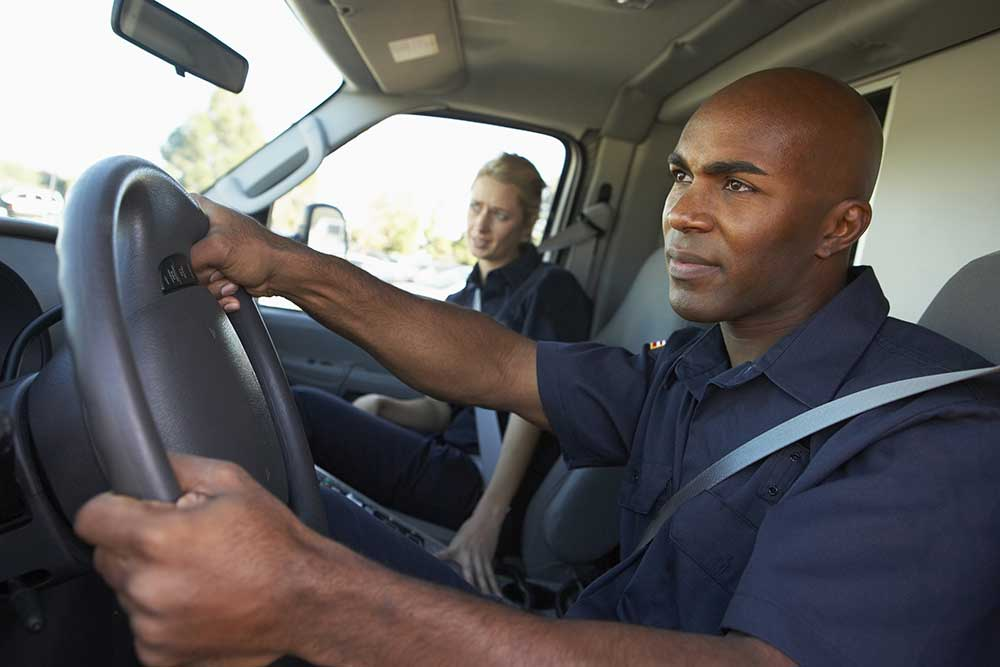
An ambulance driver is adept at driving an emergency vehicle to a spot as fast as possible. They may require to assist medical technicians in riding their ambulance and transporting patients to and from stretchers. They should know using CPR and administer first aid if necessary. Apart from transporting injured patients from one place to another, they need to perform daily tasks ensuring the equipment and the patient place is sanitized properly.
Ambulance drivers are not emergency medical technicians, they only assist the technician to transfer patient safely to the stretcher and help them load patients on to the emergency wards in the hospital. Saving lives need speed but never at the cost of control. Drivers should move patients carefully to the hospital.
They must be able to navigate the busy street quickly without endangering the public. Drivers must make sure the vehicle is fueled, cleaned, properly maintained, and always stocked with medical supplies. They must be physically fit enough to lift patients daily.
Nature of their job
Ambulance drivers job belong to the first members of the medical team and they work for hospitals, police, fire, and community first aid squads. They also work in private sectors providing emergency services for patients from a hospital to a nursing home. In some states, a large percent of ambulance drivers are volunteers while some drivers are salaried. These drivers are trained to give basic life support to injured people and they may also give advanced life support under the direct supervision of doctors. The highly skilled EMTs are paramedics.
The progression of Ambulance drivers to EMTs
These days the task of the ambulance has grown dramatically and the drivers must be trained enough to provide emergency medical services outside the hospital. Today ambulances are mini emergency rooms fully equipped with high-tech tools and life-saving machines. The Ems providers have licensed healthcare practitioners and they respond to a wide variety of medical situations. According to the statistics, the number of ambulance drivers who are not paramedics is less. At the same time, most of them are EMTs who can drive the ambulance and provide first aid too. The EMS professionals provide crucial emergency service and they do so much more than drive the ambulance.
How to become an ambulance driver
Step 1: Education
The driver needs to have at least a high school diploma or GED. Though the employer’s requirements vary, they need to be educated basic EMT level. All states require EMT and paramedics to complete a formal training program. The EMT training must comprise 80 to 120 hours of classroom education and clinical training involves the additional time of 24 hours or more. To obtain EMT certification, they must attend the exam lasting several hours including written tests and practical assessments. The drivers need to have physical stamina and some employers require them to have basic life support and CPR certification.
Step 2: Must possess a driver’s license
The candidate must possess a valid driver’s license to perform all sorts of ambulance driving jobs. Some states require special endorsement on the driver’s license to drive an ambulance. To obtain a license, candidates need to attend both the written and practical driving exam. The driver’s education course covers a few important safety concepts. The state department requires an essential licensing requirement for new ambulance drivers.
Step 3: Gain CPR certification
Even states don’t ask drivers to drivers to hold EMT certificate, employers will often require drivers to have at least CPR and BLS certification. There are short term courses available from the American Red Cross and other community colleges. CPR certification is essential for most EMT programs.
Step 4: Attend medical training programs
The state requires candidates to include current EMT basic license and the US department outlines entry-level EMT certificate programs. You can attend these programs from community college and vocational school. Hands-on training would be included. Graduates must attend a written and practical exam from NREMT to get the national certification.
Step 5: get driving certification
Some employers may provide on-the-job training and prospective drivers need to complete a safe driving course and obtain a specialized ambulance driving certificate. Many employers ask for EVOC certificates or you may obtain it after being hired. Based on the curriculum developed by the national highway traffic safety administration, the course includes classroom and practical experience. The program usually covers safe driving, navigation, and GPS and complete legal requirement needed to drive emergency vehicle drivers. The program requires the student to possess 1 year of emergency vehicle driving experience before qualifying for the certificate.
Step 6: Maintain a clean driving record
To maintain growth and employment in this field, it is necessary to keep a safe driving record. It includes no violation of traffic rules and regulations.
Top ambulance drivers skills
- CPR – The driver must possess CPR and defensive driving training certificates. Must be able to provide first aid services which include bandaging wound, administrating oxygen and CPR
- Hospital staff – Must communicate detailed medical history, vital signs, and patient information to hospital staff during patient delivery.
- Take the doctor’s appointment – the safe transportation of the patient to the doctor’s clinic. The safe return of the patient back home.
- EMT – Utilize the skills and training as EMT providing care as needed. Work as EMT as a weekly shift and perform small duties at accident sites. Maintain cleanliness inside the ambulance.
- Patient care – provide emergency care and emotional support to the patients and their families. Assist the medical team to look after sick and injured patients of all age group. Assist with patient loading and unloading including carrying patient’s equipment.
- Prepare patient care reports – ensure patient care reports were uploaded and document all the reports.
- Medical technician – accompany and assist medical technician on call.
For information related to resume, job description, cover letters visit our website Smart Sample Resume.



